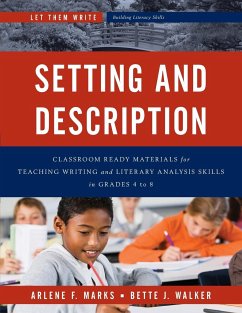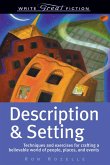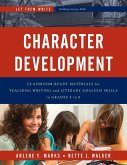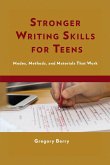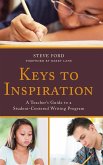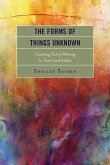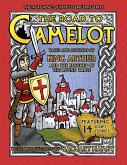Arlene F. Marks, Bette J. Walker
Setting and Description
Classroom Ready Materials for Teaching Writing and Literary Analysis Skills in Grades 4 to 8
Arlene F. Marks, Bette J. Walker
Setting and Description
Classroom Ready Materials for Teaching Writing and Literary Analysis Skills in Grades 4 to 8
- Broschiertes Buch
- Merkliste
- Auf die Merkliste
- Bewerten Bewerten
- Teilen
- Produkt teilen
- Produkterinnerung
- Produkterinnerung
Setting and Description focuses on the effective use of descriptive writing techniques to depict a story setting. Students practice first-drafting, editing, polishing and sharing original scenes and stories set in realistically described times and places.
Andere Kunden interessierten sich auch für
![Description & Setting (Write Great Fiction) Description & Setting (Write Great Fiction)]() Ron RozelleDescription & Setting (Write Great Fiction)16,99 €
Ron RozelleDescription & Setting (Write Great Fiction)16,99 €![Character Development Character Development]() Arlene F. MarksCharacter Development66,99 €
Arlene F. MarksCharacter Development66,99 €![Feedback Process Feedback Process]() Karen A. WinkFeedback Process39,99 €
Karen A. WinkFeedback Process39,99 €![Stronger Writing Skills for Teens Stronger Writing Skills for Teens]() Gregory BerryStronger Writing Skills for Teens40,99 €
Gregory BerryStronger Writing Skills for Teens40,99 €![Keys to Inspiration Keys to Inspiration]() Steve FordKeys to Inspiration78,99 €
Steve FordKeys to Inspiration78,99 €![Forms of Things Unknown Forms of Things Unknown]() Shelley SavrenForms of Things Unknown41,99 €
Shelley SavrenForms of Things Unknown41,99 €![The Road to Camelot The Road to Camelot]() Hamby, Zachary, PH.D.The Road to Camelot27,99 €
Hamby, Zachary, PH.D.The Road to Camelot27,99 €-
-
-
Setting and Description focuses on the effective use of descriptive writing techniques to depict a story setting. Students practice first-drafting, editing, polishing and sharing original scenes and stories set in realistically described times and places.
Produktdetails
- Produktdetails
- Let Them Write: Building Literacy Skills
- Verlag: Rowman & Littlefield
- Seitenzahl: 166
- Erscheinungstermin: 25. September 2015
- Englisch
- Abmessung: 280mm x 216mm x 9mm
- Gewicht: 436g
- ISBN-13: 9781475818420
- ISBN-10: 1475818424
- Artikelnr.: 42749577
- Herstellerkennzeichnung
- Libri GmbH
- Europaallee 1
- 36244 Bad Hersfeld
- gpsr@libri.de
- Let Them Write: Building Literacy Skills
- Verlag: Rowman & Littlefield
- Seitenzahl: 166
- Erscheinungstermin: 25. September 2015
- Englisch
- Abmessung: 280mm x 216mm x 9mm
- Gewicht: 436g
- ISBN-13: 9781475818420
- ISBN-10: 1475818424
- Artikelnr.: 42749577
- Herstellerkennzeichnung
- Libri GmbH
- Europaallee 1
- 36244 Bad Hersfeld
- gpsr@libri.de
Born and raised in Toronto, Arlene F. Marks found her storytelling muse at the age of 6, and she has been writing and sharing her imaginative tales ever since. She is also a retired educator and veteran teacher of the craft, having authored two literacy programs for the classroom, as well as From First Word to Last: The Craft of Writing Popular Fiction. During her life, she has worked as everything from a travel agent to a fashion consultant. However, her first love and current obsession is writing speculative fiction.Arlene lives with her husband on the shore of beautiful Nottawasaga Bay. She spends an inordinate amount of time following her characters around the universes in her mind, but she can be lured away from them by dark chocolate... and interesting owls to add to her collection. www.thewritersnest.ca
INTRODUCTION TO LET THEM WRITE
Messages from the authors
How to implement this program
The aims and objectives of this program
How to implement Let Them Read
Writing a literary essay
The aims and objectives of Let Them Read
Setting up a writer-friendly classroom
Authors need a writing plan
Publishing students' work
NCCS Anchors addressed
SECTION 1: SETTING THE SCENE
SKILL 1: DESCRIBING AN INDOORS SETTING
Students will practice using their descriptive writing skills to create a
realistic indoor setting for a scene or story, in the process becoming more
observant about their real life surroundings.
Reproducibles/Media:STR 1--MY SETTING DETAILS Worksheet
STR 2-SETTING PURPOSES Worksheet
SKILL 2: DESCRIBING AN OUTDOORS SETTING
As students practice using their descriptive writing skills to create a
realistic outdoor setting for a scene or story, they may become more aware
of the natural world around them.
SKILL 3: DESCRIBING AN OCCASIONALLY VISITED LOCATION
Students will practice creating a realistic story setting using their
descriptive writing skills, in the process increasing their bank of
descriptive vocabulary.
SKILL 4: DESCRIBING A MODE OF TRANSPORTATION
As students practice describing the interior of a transportation vehicle,
they will also be expanding their active vocabulary.
SKILL 5: REVEALING SETTING TO THE READER
Young authors will learn and practice one effective way to include setting
details in the introduction to a scene or story.
Reproducibles/Media:STR 3--REVEALING SETTING TO THE READER
SECTION 2: INCLUDING SENSORY DETAIL
SKILL 1: USING THE SENSE OF SMELLAs young authors become aware of and
familiar with a variety of different smells, they will also increase their
active vocabulary by practicing different ways to describe them.
Reproducibles/Media:STR 4--EXAMPLE PARAGRAPHS SHEETSTR 5--SENSE OF SMELL
CHARTSKILL 2: USING THE SENSE OF TOUCHIn order to make their writing come
alive with sensory details, students will experience a variety of different
textures and practice ways to describe them.
Reproducibles/Media:STR 6--EXAMPLE PARAGRAPHS SHEETSTR 7--SENSE OF TOUCH
CHARTSKILL 3: USING THE SENSE OF TASTEYoung authors will learn about and
practice making their writing more vivid by including interesting
descriptions of taste where appropriate.
Reproducibles/Media:STR 8--EXAMPLE PARAGRAPHS SHEET STR 9--SENSE OF TASTE
CHARTSKILL 4: USING THE SENSE OF HEARINGStudents will practice listening to
and describing a variety of sounds in order to enrich their writing with
authentic auditory details. In the process, they will become more aware of
their everyday environment.
Reproducibles/Media:STR 10--EXAMPLE PARAGRAPHS SHEET
STR 11--SENSE OF HEARING CHART
SKILL 5: USING THE SENSE OF SIGHT
Young authors will hone their observational skills as they learn how to
select those details which will help a reader to visualize what an author
is describing.
SKILL 6: ACTION DESCRIPTIONAs students practice using colorful verbs to
make action scenes come alive for a reader, they will also be learning how
to use a thesaurus and dictionary to expand their active vocabulary.
Reproducibles/Media:STR 12-ACTION DESCRIPTION PATTERN A WORKSHEET STR
13-ACTION DESCRIPTION PATTERN B WORKSHEET
SECTION 3: INCLUDING FIGURATIVE LANGUAGE
SKILL 1: SIMILES TO DESCRIBE APPEARANCESYoung authors will learn about and
practice making their descriptive writing more interesting and powerful
through the use of simile, a figurative comparison.
Reproducibles/Media:STR 14--SIMILES TO DESCRIBE APPEARANCES WorksheetSKILL
2: SIMILES TO DESCRIBE ACTIONSYoung authors will practice using simile to
make a character's actions easier for a reader to visualize, in the process
adding strength and drama to their writing.
Reproducibles/Media:STR 15-SIMILES TO DESCRIBE ACTIONS Worksheet SKILL 3:
USING METAPHORS Students will learn about and practice using metaphor to
paint vivid language pictures in a reader's mind.
Reproducibles/Media:STR 16--METAPHORS WORKSHEETSKILL 4: USING
ONOMATOPOEIAAs young authors practice including in their descriptions words
that are interesting to listen to as well as read, they will increase their
sensitivity to the music of language.
SKILL 5: USING SYNESTHESIAStudents will learn how to make their
descriptions memorable by substituting one sense for another.
Reproducibles/Media:STR 17--SYNESTHESIA WORKSHEET
Messages from the authors
How to implement this program
The aims and objectives of this program
How to implement Let Them Read
Writing a literary essay
The aims and objectives of Let Them Read
Setting up a writer-friendly classroom
Authors need a writing plan
Publishing students' work
NCCS Anchors addressed
SECTION 1: SETTING THE SCENE
SKILL 1: DESCRIBING AN INDOORS SETTING
Students will practice using their descriptive writing skills to create a
realistic indoor setting for a scene or story, in the process becoming more
observant about their real life surroundings.
Reproducibles/Media:STR 1--MY SETTING DETAILS Worksheet
STR 2-SETTING PURPOSES Worksheet
SKILL 2: DESCRIBING AN OUTDOORS SETTING
As students practice using their descriptive writing skills to create a
realistic outdoor setting for a scene or story, they may become more aware
of the natural world around them.
SKILL 3: DESCRIBING AN OCCASIONALLY VISITED LOCATION
Students will practice creating a realistic story setting using their
descriptive writing skills, in the process increasing their bank of
descriptive vocabulary.
SKILL 4: DESCRIBING A MODE OF TRANSPORTATION
As students practice describing the interior of a transportation vehicle,
they will also be expanding their active vocabulary.
SKILL 5: REVEALING SETTING TO THE READER
Young authors will learn and practice one effective way to include setting
details in the introduction to a scene or story.
Reproducibles/Media:STR 3--REVEALING SETTING TO THE READER
SECTION 2: INCLUDING SENSORY DETAIL
SKILL 1: USING THE SENSE OF SMELLAs young authors become aware of and
familiar with a variety of different smells, they will also increase their
active vocabulary by practicing different ways to describe them.
Reproducibles/Media:STR 4--EXAMPLE PARAGRAPHS SHEETSTR 5--SENSE OF SMELL
CHARTSKILL 2: USING THE SENSE OF TOUCHIn order to make their writing come
alive with sensory details, students will experience a variety of different
textures and practice ways to describe them.
Reproducibles/Media:STR 6--EXAMPLE PARAGRAPHS SHEETSTR 7--SENSE OF TOUCH
CHARTSKILL 3: USING THE SENSE OF TASTEYoung authors will learn about and
practice making their writing more vivid by including interesting
descriptions of taste where appropriate.
Reproducibles/Media:STR 8--EXAMPLE PARAGRAPHS SHEET STR 9--SENSE OF TASTE
CHARTSKILL 4: USING THE SENSE OF HEARINGStudents will practice listening to
and describing a variety of sounds in order to enrich their writing with
authentic auditory details. In the process, they will become more aware of
their everyday environment.
Reproducibles/Media:STR 10--EXAMPLE PARAGRAPHS SHEET
STR 11--SENSE OF HEARING CHART
SKILL 5: USING THE SENSE OF SIGHT
Young authors will hone their observational skills as they learn how to
select those details which will help a reader to visualize what an author
is describing.
SKILL 6: ACTION DESCRIPTIONAs students practice using colorful verbs to
make action scenes come alive for a reader, they will also be learning how
to use a thesaurus and dictionary to expand their active vocabulary.
Reproducibles/Media:STR 12-ACTION DESCRIPTION PATTERN A WORKSHEET STR
13-ACTION DESCRIPTION PATTERN B WORKSHEET
SECTION 3: INCLUDING FIGURATIVE LANGUAGE
SKILL 1: SIMILES TO DESCRIBE APPEARANCESYoung authors will learn about and
practice making their descriptive writing more interesting and powerful
through the use of simile, a figurative comparison.
Reproducibles/Media:STR 14--SIMILES TO DESCRIBE APPEARANCES WorksheetSKILL
2: SIMILES TO DESCRIBE ACTIONSYoung authors will practice using simile to
make a character's actions easier for a reader to visualize, in the process
adding strength and drama to their writing.
Reproducibles/Media:STR 15-SIMILES TO DESCRIBE ACTIONS Worksheet SKILL 3:
USING METAPHORS Students will learn about and practice using metaphor to
paint vivid language pictures in a reader's mind.
Reproducibles/Media:STR 16--METAPHORS WORKSHEETSKILL 4: USING
ONOMATOPOEIAAs young authors practice including in their descriptions words
that are interesting to listen to as well as read, they will increase their
sensitivity to the music of language.
SKILL 5: USING SYNESTHESIAStudents will learn how to make their
descriptions memorable by substituting one sense for another.
Reproducibles/Media:STR 17--SYNESTHESIA WORKSHEET
INTRODUCTION TO LET THEM WRITE
Messages from the authors
How to implement this program
The aims and objectives of this program
How to implement Let Them Read
Writing a literary essay
The aims and objectives of Let Them Read
Setting up a writer-friendly classroom
Authors need a writing plan
Publishing students' work
NCCS Anchors addressed
SECTION 1: SETTING THE SCENE
SKILL 1: DESCRIBING AN INDOORS SETTING
Students will practice using their descriptive writing skills to create a
realistic indoor setting for a scene or story, in the process becoming more
observant about their real life surroundings.
Reproducibles/Media:STR 1--MY SETTING DETAILS Worksheet
STR 2-SETTING PURPOSES Worksheet
SKILL 2: DESCRIBING AN OUTDOORS SETTING
As students practice using their descriptive writing skills to create a
realistic outdoor setting for a scene or story, they may become more aware
of the natural world around them.
SKILL 3: DESCRIBING AN OCCASIONALLY VISITED LOCATION
Students will practice creating a realistic story setting using their
descriptive writing skills, in the process increasing their bank of
descriptive vocabulary.
SKILL 4: DESCRIBING A MODE OF TRANSPORTATION
As students practice describing the interior of a transportation vehicle,
they will also be expanding their active vocabulary.
SKILL 5: REVEALING SETTING TO THE READER
Young authors will learn and practice one effective way to include setting
details in the introduction to a scene or story.
Reproducibles/Media:STR 3--REVEALING SETTING TO THE READER
SECTION 2: INCLUDING SENSORY DETAIL
SKILL 1: USING THE SENSE OF SMELLAs young authors become aware of and
familiar with a variety of different smells, they will also increase their
active vocabulary by practicing different ways to describe them.
Reproducibles/Media:STR 4--EXAMPLE PARAGRAPHS SHEETSTR 5--SENSE OF SMELL
CHARTSKILL 2: USING THE SENSE OF TOUCHIn order to make their writing come
alive with sensory details, students will experience a variety of different
textures and practice ways to describe them.
Reproducibles/Media:STR 6--EXAMPLE PARAGRAPHS SHEETSTR 7--SENSE OF TOUCH
CHARTSKILL 3: USING THE SENSE OF TASTEYoung authors will learn about and
practice making their writing more vivid by including interesting
descriptions of taste where appropriate.
Reproducibles/Media:STR 8--EXAMPLE PARAGRAPHS SHEET STR 9--SENSE OF TASTE
CHARTSKILL 4: USING THE SENSE OF HEARINGStudents will practice listening to
and describing a variety of sounds in order to enrich their writing with
authentic auditory details. In the process, they will become more aware of
their everyday environment.
Reproducibles/Media:STR 10--EXAMPLE PARAGRAPHS SHEET
STR 11--SENSE OF HEARING CHART
SKILL 5: USING THE SENSE OF SIGHT
Young authors will hone their observational skills as they learn how to
select those details which will help a reader to visualize what an author
is describing.
SKILL 6: ACTION DESCRIPTIONAs students practice using colorful verbs to
make action scenes come alive for a reader, they will also be learning how
to use a thesaurus and dictionary to expand their active vocabulary.
Reproducibles/Media:STR 12-ACTION DESCRIPTION PATTERN A WORKSHEET STR
13-ACTION DESCRIPTION PATTERN B WORKSHEET
SECTION 3: INCLUDING FIGURATIVE LANGUAGE
SKILL 1: SIMILES TO DESCRIBE APPEARANCESYoung authors will learn about and
practice making their descriptive writing more interesting and powerful
through the use of simile, a figurative comparison.
Reproducibles/Media:STR 14--SIMILES TO DESCRIBE APPEARANCES WorksheetSKILL
2: SIMILES TO DESCRIBE ACTIONSYoung authors will practice using simile to
make a character's actions easier for a reader to visualize, in the process
adding strength and drama to their writing.
Reproducibles/Media:STR 15-SIMILES TO DESCRIBE ACTIONS Worksheet SKILL 3:
USING METAPHORS Students will learn about and practice using metaphor to
paint vivid language pictures in a reader's mind.
Reproducibles/Media:STR 16--METAPHORS WORKSHEETSKILL 4: USING
ONOMATOPOEIAAs young authors practice including in their descriptions words
that are interesting to listen to as well as read, they will increase their
sensitivity to the music of language.
SKILL 5: USING SYNESTHESIAStudents will learn how to make their
descriptions memorable by substituting one sense for another.
Reproducibles/Media:STR 17--SYNESTHESIA WORKSHEET
Messages from the authors
How to implement this program
The aims and objectives of this program
How to implement Let Them Read
Writing a literary essay
The aims and objectives of Let Them Read
Setting up a writer-friendly classroom
Authors need a writing plan
Publishing students' work
NCCS Anchors addressed
SECTION 1: SETTING THE SCENE
SKILL 1: DESCRIBING AN INDOORS SETTING
Students will practice using their descriptive writing skills to create a
realistic indoor setting for a scene or story, in the process becoming more
observant about their real life surroundings.
Reproducibles/Media:STR 1--MY SETTING DETAILS Worksheet
STR 2-SETTING PURPOSES Worksheet
SKILL 2: DESCRIBING AN OUTDOORS SETTING
As students practice using their descriptive writing skills to create a
realistic outdoor setting for a scene or story, they may become more aware
of the natural world around them.
SKILL 3: DESCRIBING AN OCCASIONALLY VISITED LOCATION
Students will practice creating a realistic story setting using their
descriptive writing skills, in the process increasing their bank of
descriptive vocabulary.
SKILL 4: DESCRIBING A MODE OF TRANSPORTATION
As students practice describing the interior of a transportation vehicle,
they will also be expanding their active vocabulary.
SKILL 5: REVEALING SETTING TO THE READER
Young authors will learn and practice one effective way to include setting
details in the introduction to a scene or story.
Reproducibles/Media:STR 3--REVEALING SETTING TO THE READER
SECTION 2: INCLUDING SENSORY DETAIL
SKILL 1: USING THE SENSE OF SMELLAs young authors become aware of and
familiar with a variety of different smells, they will also increase their
active vocabulary by practicing different ways to describe them.
Reproducibles/Media:STR 4--EXAMPLE PARAGRAPHS SHEETSTR 5--SENSE OF SMELL
CHARTSKILL 2: USING THE SENSE OF TOUCHIn order to make their writing come
alive with sensory details, students will experience a variety of different
textures and practice ways to describe them.
Reproducibles/Media:STR 6--EXAMPLE PARAGRAPHS SHEETSTR 7--SENSE OF TOUCH
CHARTSKILL 3: USING THE SENSE OF TASTEYoung authors will learn about and
practice making their writing more vivid by including interesting
descriptions of taste where appropriate.
Reproducibles/Media:STR 8--EXAMPLE PARAGRAPHS SHEET STR 9--SENSE OF TASTE
CHARTSKILL 4: USING THE SENSE OF HEARINGStudents will practice listening to
and describing a variety of sounds in order to enrich their writing with
authentic auditory details. In the process, they will become more aware of
their everyday environment.
Reproducibles/Media:STR 10--EXAMPLE PARAGRAPHS SHEET
STR 11--SENSE OF HEARING CHART
SKILL 5: USING THE SENSE OF SIGHT
Young authors will hone their observational skills as they learn how to
select those details which will help a reader to visualize what an author
is describing.
SKILL 6: ACTION DESCRIPTIONAs students practice using colorful verbs to
make action scenes come alive for a reader, they will also be learning how
to use a thesaurus and dictionary to expand their active vocabulary.
Reproducibles/Media:STR 12-ACTION DESCRIPTION PATTERN A WORKSHEET STR
13-ACTION DESCRIPTION PATTERN B WORKSHEET
SECTION 3: INCLUDING FIGURATIVE LANGUAGE
SKILL 1: SIMILES TO DESCRIBE APPEARANCESYoung authors will learn about and
practice making their descriptive writing more interesting and powerful
through the use of simile, a figurative comparison.
Reproducibles/Media:STR 14--SIMILES TO DESCRIBE APPEARANCES WorksheetSKILL
2: SIMILES TO DESCRIBE ACTIONSYoung authors will practice using simile to
make a character's actions easier for a reader to visualize, in the process
adding strength and drama to their writing.
Reproducibles/Media:STR 15-SIMILES TO DESCRIBE ACTIONS Worksheet SKILL 3:
USING METAPHORS Students will learn about and practice using metaphor to
paint vivid language pictures in a reader's mind.
Reproducibles/Media:STR 16--METAPHORS WORKSHEETSKILL 4: USING
ONOMATOPOEIAAs young authors practice including in their descriptions words
that are interesting to listen to as well as read, they will increase their
sensitivity to the music of language.
SKILL 5: USING SYNESTHESIAStudents will learn how to make their
descriptions memorable by substituting one sense for another.
Reproducibles/Media:STR 17--SYNESTHESIA WORKSHEET

